
Exercise Paddington Diamond was a joint Bolivian-British-Swiss scuba diving expedition to Lake Titicaca in 1987. [1]

Exercise Paddington Diamond was a joint Bolivian-British-Swiss scuba diving expedition to Lake Titicaca in 1987. [1]
In early 1987 the British Army of the Rhine (BAOR) arranged a group of adventure training exercises for military personnel in the high Andes of Peru and Bolivia. These exercises were identified by the group name ‘Paddington’ (a reference to Paddington Bear, a fictional children's character created by author Michael Bond and said to be from Peru). Under that umbrella were a number of expedition groups pursuing different activities: hiking, caving etc. The designations identifying individual groups were ‘Paddington’ followed by the name of a geometric shape. [lower-alpha 1] The caving group in Peru was ‘Paddington Triangle’. The diving expedition to the Bolivian waters of Lake Titicaca was Paddington Diamond.
Exercise Paddington Diamond was a collaborative venture hosted by the Bolivian Navy [lower-alpha 2] out of their San Pedro naval base in the Strait of Tiquina, Lake Titicaca. This is the highest navigable lake in the world at an altitude of 3,810 m (12,500 feet). The Bolivian Navy had a history of diving in the lake and wished to keep up to date its understanding of the technical and medical aspects of diving at such extreme altitudes. The purpose of Exercise Paddington Diamond was to work with the navy to test under field conditions the latest generation of dive computers and the high altitude decompression algorithms they used. In line with this objective Professor Albert Bühlmann of the University of Zürich, the world's leading expert on diving at altitude, provided the expedition with new decompression tables for diving up to 4,500m above sea level. Through Professor Bühlmann's contacts with Swiss instrument manufacturers the expedition's two models of diving computer were pre-programmed with these latest calculations. The new tables had been verified in a decompression chamber in Zürich but had not yet been evaluated in open water. [lower-alpha 3]
A subsidiary objective of Paddington Diamond was to use the planned dive programme to increase understanding of the Lake Titicaca environment by conducting underwater surveys of localised regions to seek submerged Inca or other ruins, and by undertaking detailed collections of animal and plant life using the precision only possible with the use of scuba techniques.
The British party comprised diving personnel from a range of British army regiments and from the Royal Air Force but to support the expedition's objectives a number of civilian specialists were also recruited. These included an expert in dive computers and high altitude dive tables from the University of Zürich; a doctor with expertise in diving medicine and a nurse, both from Geneva (to support the Bolivian naval doctor and British army doctor already on the team); an equipment specialist from the British Sub-Aqua Club; and a diver from the Natural History Museum in London as expedition biologist. This took the British/Swiss contingent to 16 individuals.
The Bolivian Navy provided a commanding officer, a physician with expertise in high altitude medicine, four divers, two dive launches with crews, and full logistical support in the form of equipment, security personnel and extensive camp facilities. They also brought local knowledge and public outreach capabilities to the team. [lower-alpha 4]
After two days of acclimatisation to altitude in La Paz the European members moved up to the lake on 5 May 1987 and joined the navy group who had set up a tented camp on the shore at Santiago de Ojje. Diving commenced the following day and continued up to and including 11 May. In this period there were 34 logged expedition dives varying in depth from 2m to 21.5m and in duration from 4 minutes to 45 minutes. [lower-alpha 5] [lower-alpha 6]
After two rest days, on 14 May the expedition moved to Challa Bay on the Island of the Sun. Diving commenced here on the 15th and continued up to and including 27 May with a rest day on the 21st. At Challa there were 99 logged dives varying in depth from 4m to 38m and in duration from 3 minutes to 66 minutes. [lower-alpha 7]
The dive tables and computers were tested during a range of dive types, after which the two designs of computer were cross referenced and checked against the recommendations of the new Bühlmann tables. Many dives were deliberately planned to employ a rectangular profile, the form best suited to match the assumptions of the calculations and act as a test of the decompression recommendations. Survey and habitat sampling dives differed in that they often began and ended on shore and were not controlled profiles. [lower-alpha 8] They were also shallower than many of the dives made specifically to test the tables and computers.
After each dive the returning divers were subjected to a regime of medical examinations to check for early signs of nitrogen bubbles forming in the body (the cause of decompression sickness, ‘the bends’). No signs of decompression problems were found.
Following this programme of dives the Bolivian Navy officially adopted the new Bühlmann tables for all diving operations at altitude.
No new ruins, structures or Inca artefacts were discovered during the expedition but many scientifically valuable biological collections and observations were made, especially of the smaller amphipod crustaceans of the lake. These were already known to be undergoing active species formation in Lake Titicaca and have the potential to provide valuable information regarding the process of evolution in the lake and, by extension, elsewhere. These collections were returned to the Natural History Museum in London for further study by world experts. [lower-alpha 9]
Throughout the expedition there had been media coverage in the UK press and on Bolivian television and radio. After the expedition Services Sound and Vision Corporation (SSVC) produced a 20-minute television news documentary about the expedition for broadcast on the British Forces Broadcasting Service (BFBS), which also ran radio items. [lower-alpha 10]
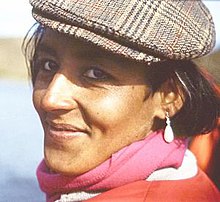
On Thursday 7 May 1987 the expedition's Swiss nurse Annie Jean-Alexis made a brief 4 minute dive to a depth of 2m, abandoned for technical reasons. Nevertheless, she was possibly the first woman to dive in Lake Titicaca. Two days later she made a more successful descent to a depth of 3m for 15 minutes. [lower-alpha 11]
Also on 9 May two women dived during a visit by the UK Naval Attaché and his staff. [lower-alpha 12] As this diplomatic party was not undertaking expedition work dives, the logs for these dives are not reproduced in the published report and the names of the two divers are not recorded there. However, in the unpublished diary of an expedition member it is noted their first names were Sylvia (or Silvia) and Marita. [lower-alpha 13] Sylvia/Silvia was a member of the British embassy staff; Marita was a Swedish volunteer worker known to the embassy.
On 17 May Sarah Last, a PR executive from BAOR, made a 15-minute dive to 6.4m during a visit by a media team from the SSVC who had joined the expedition for several days to produce TV and radio news programmes. [lower-alpha 14]
Therefore, during Exercise Paddington Diamond at least four women dived with aqualungs in Lake Titicaca and may have been the first four to do so. The Bolivian Navy now trains female military personnel, as well as men, in high altitude diving, equipping them for search and rescue operations in the lake.
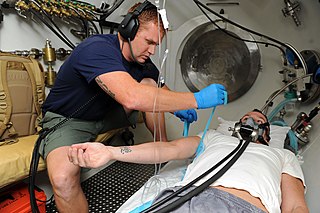
Decompression sickness is a medical condition caused by dissolved gases emerging from solution as bubbles inside the body tissues during decompression. DCS most commonly occurs during or soon after a decompression ascent from underwater diving, but can also result from other causes of depressurisation, such as emerging from a caisson, decompression from saturation, flying in an unpressurised aircraft at high altitude, and extravehicular activity from spacecraft. DCS and arterial gas embolism are collectively referred to as decompression illness.

Altitude diving is underwater diving using scuba or surface supplied diving equipment where the surface is 300 metres (980 ft) or more above sea level. Altitude is significant in diving because it affects the decompression requirement for a dive, so that the stop depths and decompression times used for dives at altitude are different from those used for the same dive profile at sea level. The U.S. Navy tables recommend that no alteration be made for dives at altitudes lower than 91 metres (299 ft) and for dives between 91 and 300 meters correction is required for dives deeper than 44 metres (144 ft) of sea water. Most recently manufactured decompression computers can automatically compensate for altitude.

A dive computer, personal decompression computer or decompression meter is a device used by an underwater diver to measure the elapsed time and depth during a dive and use this data to calculate and display an ascent profile which, according to the programmed decompression algorithm, will give a low risk of decompression sickness.
The equivalent air depth (EAD) is a way of approximating the decompression requirements of breathing gas mixtures that contain nitrogen and oxygen in different proportions to those in air, known as nitrox.
The Bühlmann decompression set of parameters is an Haldanian mathematical model (algorithm) of the way in which inert gases enter and leave the human body as the ambient pressure changes. Versions are used to create Bühlmann decompression tables and in personal dive computers to compute no-decompression limits and decompression schedules for dives in real-time. These decompression tables allow divers to plan the depth and duration for dives and the required decompression stops.

A dive profile is a description of a diver's pressure exposure over time. It may be as simple as just a depth and time pair, as in: "sixty for twenty," or as complex as a second by second graphical representation of depth and time recorded by a personal dive computer. Several common types of dive profile are specifically named, and these may be characteristic of the purpose of the dive. For example, a working dive at a limited location will often follow a constant depth (square) profile, and a recreational dive is likely to follow a multilevel profile, as the divers start deep and work their way up a reef to get the most out of the available breathing gas. The names are usually descriptive of the graphic appearance.
Ratio decompression is a technique for calculating decompression schedules for scuba divers engaged in deep diving without using dive tables, decompression software or a dive computer. It is generally taught as part of the "DIR" philosophy of diving promoted by organisations such Global Underwater Explorers (GUE) Innerspace Explorers (ISE) and Unified Team Diving (UTD) at the advanced technical diving level. It is designed for decompression diving executed deeper than standard recreational diving depth limits using trimix as a "bottom mix" breathing gas.
Albert Alois Bühlmann was a Swiss physician who was principally responsible for a number of important contributions to decompression science at the Laboratory of Hyperbaric Physiology at the University Hospital in Zürich, Switzerland. His impact on diving ranged from complex commercial and military diving to the occasional recreational diver. He is held in high regard for his professional ethics and attention to his research subjects.

In underwater diving, ascending and descending is done using strict protocols to avoid problems caused by the changes in ambient pressure and the hazards of obstacles near the surface such as collision with vessels. Diver certification and accreditation organisations place importance on these protocols early in their diver training programmes. Ascent and descent are historically the times when divers are injured most often when failing to follow appropriate procedure.

The decompression of a diver is the reduction in ambient pressure experienced during ascent from depth. It is also the process of elimination of dissolved inert gases from the diver's body which accumulate during ascent, largely during pauses in the ascent known as decompression stops, and after surfacing, until the gas concentrations reach equilibrium. Divers breathing gas at ambient pressure need to ascend at a rate determined by their exposure to pressure and the breathing gas in use. A diver who only breathes gas at atmospheric pressure when free-diving or snorkelling will not usually need to decompress, Divers using an atmospheric diving suit do not need to decompress as they are never exposed to high ambient pressure.

The practice of decompression by divers comprises the planning and monitoring of the profile indicated by the algorithms or tables of the chosen decompression model, to allow asymptomatic and harmless release of excess inert gases dissolved in the tissues as a result of breathing at ambient pressures greater than surface atmospheric pressure, the equipment available and appropriate to the circumstances of the dive, and the procedures authorized for the equipment and profile to be used. There is a large range of options in all of these aspects.

Decompression in the context of diving derives from the reduction in ambient pressure experienced by the diver during the ascent at the end of a dive or hyperbaric exposure and refers to both the reduction in pressure and the process of allowing dissolved inert gases to be eliminated from the tissues during this reduction in pressure.
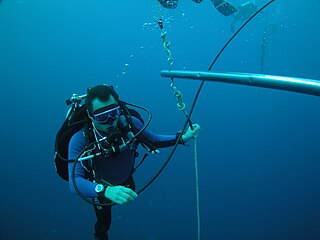
Decompression theory is the study and modelling of the transfer of the inert gas component of breathing gases from the gas in the lungs to the tissues and back during exposure to variations in ambient pressure. In the case of underwater diving and compressed air work, this mostly involves ambient pressures greater than the local surface pressure, but astronauts, high altitude mountaineers, and travellers in aircraft which are not pressurised to sea level pressure, are generally exposed to ambient pressures less than standard sea level atmospheric pressure. In all cases, the symptoms caused by decompression occur during or within a relatively short period of hours, or occasionally days, after a significant pressure reduction.
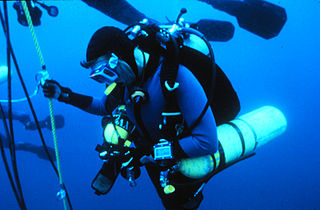
A Pyle stop is a type of short, optional deep decompression stop performed by scuba divers at depths well below the first decompression stop mandated by a conventional dissolved phase decompression algorithm, such as the US Navy or Bühlmann decompression algorithms. They were named after Richard Pyle, an American ichthyologist from Hawaii, who found that they prevented his post-dive fatigue symptoms after deep dives to collect fish specimens.
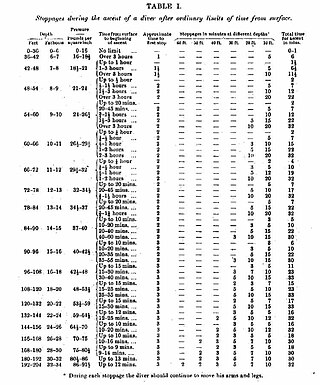
Haldane's decompression model is a mathematical model for decompression to sea level atmospheric pressure of divers breathing compressed air at ambient pressure that was proposed in 1908 by the Scottish physiologist, John Scott Haldane, who was also famous for intrepid self-experimentation.

There are several categories of decompression equipment used to help divers decompress, which is the process required to allow divers to return to the surface safely after spending time underwater at higher ambient pressures.

The following index is provided as an overview of and topical guide to underwater diving:

The U.S. Navy Diving Manual is a book used by the US Navy for diver training and diving operations.
The US Navy has used several decompression models from which their published decompression tables and authorized diving computer algorithms have been derived. The original C&R tables used a classic multiple independent parallel compartment model based on the work of J.S.Haldane in England in the early 20th century, using a critical ratio exponential ingassing and outgassing model. Later they were modified by O.D. Yarborough and published in 1937. A version developed by Des Granges was published in 1956. Further developments by M.W. Goodman and Robert D. Workman using a critical supersaturation approach to incorporate M-values, and expressed as an algorithm suitable for programming were published in 1965, and later again a significantly different model, the VVAL 18 exponential/linear model was developed by Edward D. Thalmann, using an exponential ingassing model and a combined exponential and linear outgassing model, which was further developed by Gerth and Doolette and published in Revision 6 of the US Navy Diving Manual as the 2008 tables.